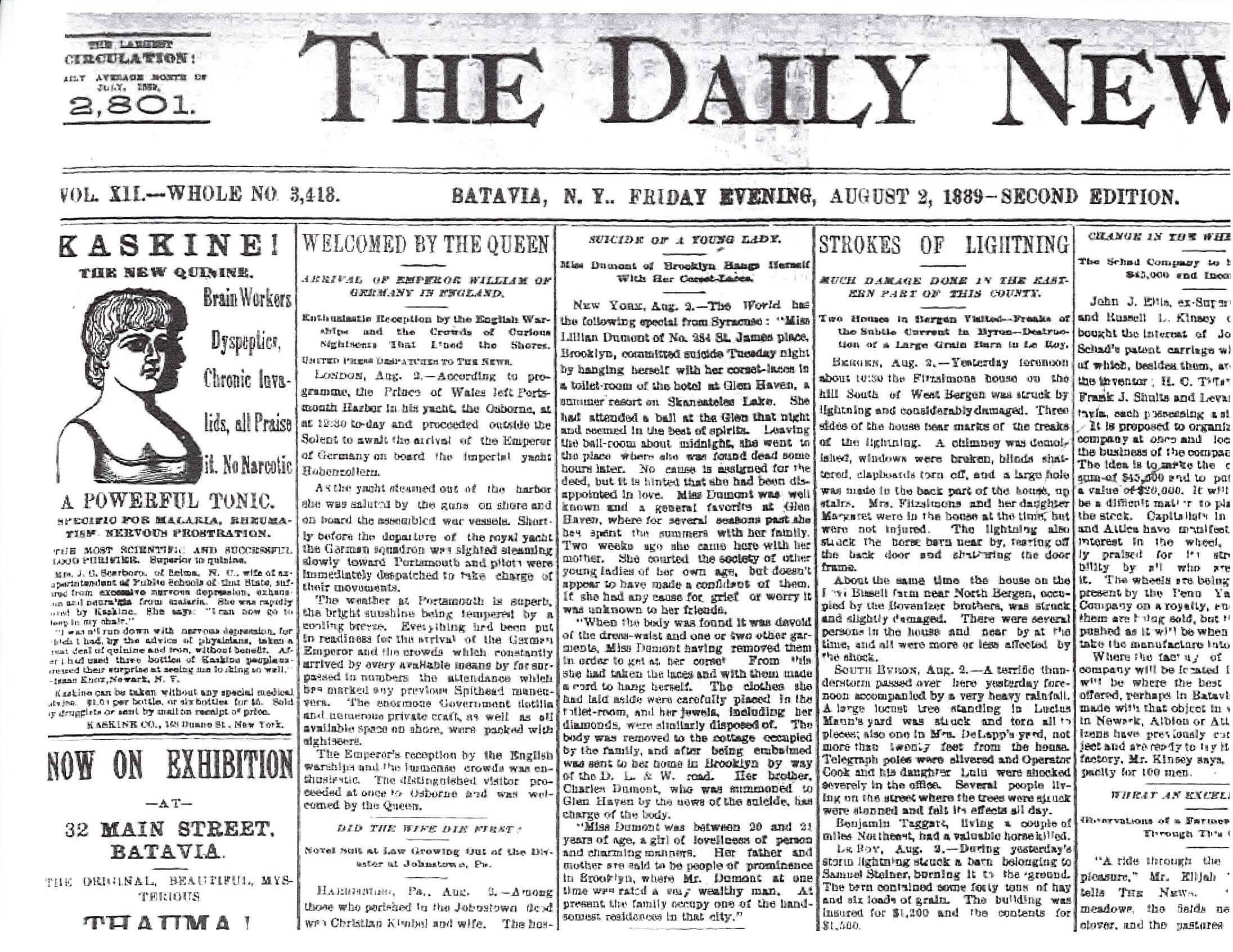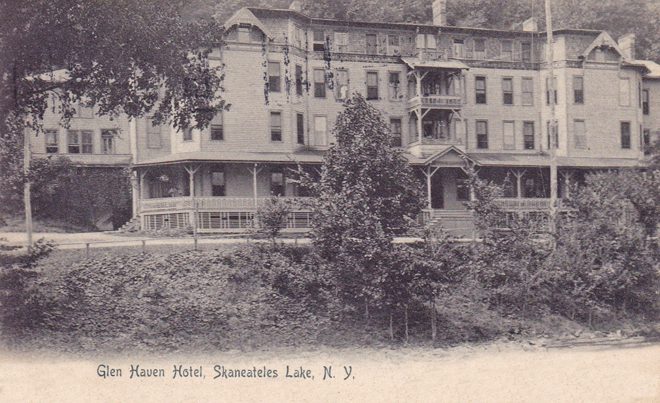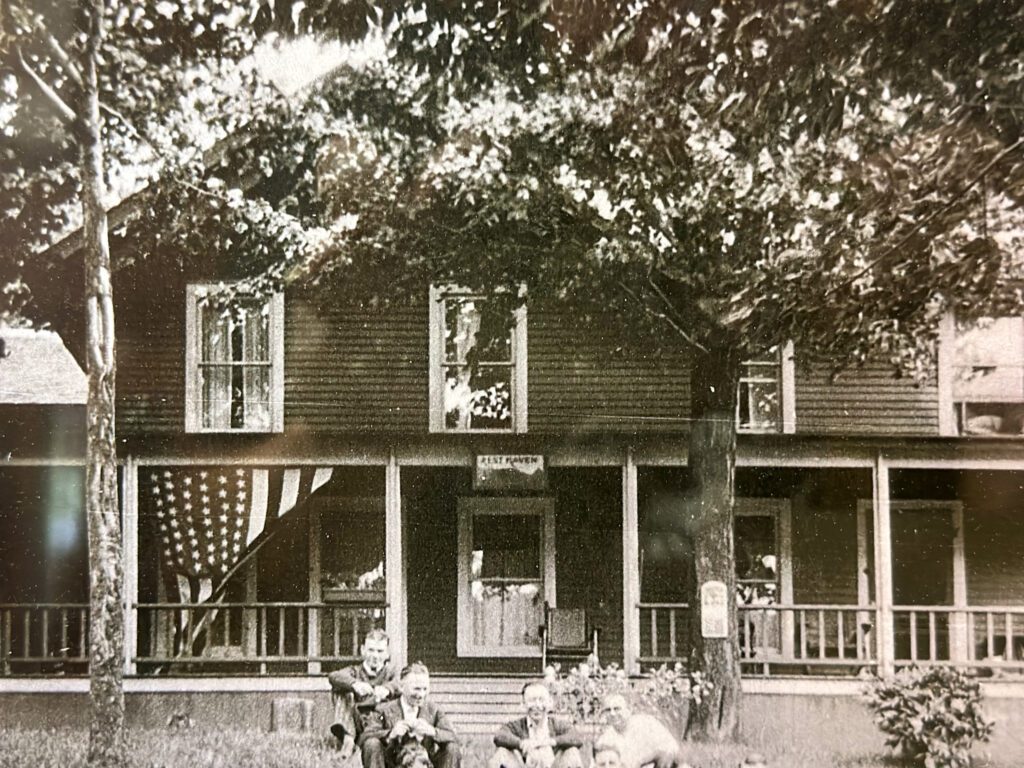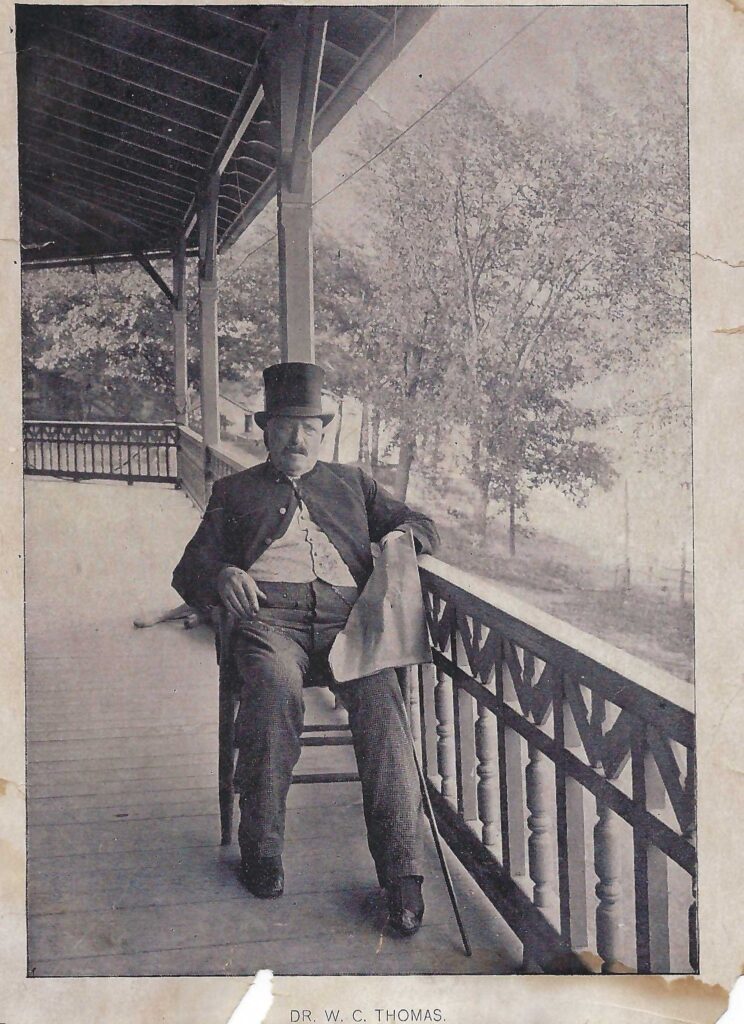Under the inky skies of a new moon, tortured screams can be heard echoing, tumbling over the ragged cliffs and across the southern shores of Skaneateles Lake. Who is this tormented soul who has haunted these hills for generations?
Location #1: The Glen Haven Historical Society at 7325 Fair Haven Rd,
Homer, NY
(42.7618622924319, -76.26748728835709)
Tales of the Glen Haven Screamer have been told for generations. Its first documented telling appears to be at Lourdes Camp on Ten Mile Point in the 70s. Although, its tale terrorized many a poor soul long before the unsuspecting children at this Skaneateles summer camp.
According to ScaryHQ.com, the ghost of Skaneateles was that of a nasty, jealous caretaker who perished in a fire at Glen Haven Sanitarium. While we can find no record of a death by fire at the Glen Haven, we certainly can find many folks who will attest to having heard the Glen Haven’s moans and screams echoing off the cliffs of Skaneateles Lake.
So, who then, is this tortured soul destined to haunt the southern shores of Skaneateles Lake for all eternity?
We began our search at the archives of Glen Haven School & Public Library. Dedicated in 1901, “the roots of the library and connection with the District 4 School Board are deeply embedded in the Glen Haven Sanatorium Summer Home,” writes Alice Anderson in ReEcho.
The Echo, a local newspaper established to raise funds for the building of this library, carried the news, stories and gossip of the folk who frequented the Glen Haven Sanitarium Summer Home. Many of its back issues are archived here, in what now serves as the Glen Haven Historical Society. This was the perfect place to begin our ghost hunt.
Perhaps the screamer is the forlorn spirit of Dr. W. C. Thomas, long-time head of the Glen Haven Sanatorium. According to the Sanitarium Ledger, “Dr. William C. Thomas died at 8 o’clock Wednesday morning at the Glen Haven Sanatorium, of which for more than forty years past he had been the head. He had been ill since about Christmas time and confined to his bed, his troubles seemed to be a gradual dying out of vital force, showing itself in a failing heart and general breaking down of the system.”
While the good doctor did not perish in a fire, he did indeed die in the sanitarium on February 7, 1900. According to ScaryHQ.com the ghost pacing the wooded cliffs above, wailing and brandishing his sharpened scythe and appears as a man. However, Dr. Thomas was not the only soul to meet their untimely demise at The Glen Haven.
Cortland County Death Notices & Obituaries published on August 2, 1889
“On Wednesday morning, the guests at Glen Haven Sanitarium were both startled and shocked by the announcement that Miss Lillian Dumont, eldest daughter of Mr. and Mrs. H. D. Dumont of Brooklyn, had committed suicide. Miss Dumont had many friends in this place, where she has frequently visited the family of her uncle Mr. John H. Hull, and the Democrat at once sent a reporter to learn the full particulars. For some weeks past, Mr. and Mrs. Dumont and daughters Lillian and Mabel have been occupying the first floor of the cottage known as “Liberty Hall” located near the old hotel. They took their meals at the new hotel, and when Mrs. Dumont looked into Lillian’s room at 8 o’clock on Wednesday morning on her way to breakfast, the girl seemed to be asleep, and she concluded not to disturb her. Mrs. Dumont was gone not to exceed fifteen minutes, and she brought some breakfast for Lillian, but when she entered the room, the bed was unoccupied. Thinking Lillian was in the closet, she went to the door and, calling her name, asked to be admitted. Just then, she noticed a hand protruding from the closet, and she at once gave the alarm. Some ladies who happened to be near rushed in, and the door being opened, Lillian was found hanging to the same. The cord was cut, and the body laid upon the bed. She gasped a few times, but all efforts to resuscitate her were unavailing.
She had taken four corset laces, tied a knot in one end and fastening the knotted end firmly in the top of the door, stood upon the bed and, after tying the other end of the laces about her neck, jumped into the closet. The weight of her body had almost closed the door. Miss Dumont was about 22 years of age and was a very beautiful and amiable young lady and had many admirers. Every wish of hers had been anticipated by her fond parents, and the cause that led her to commit the deed is as much a mystery to them as to her many friends. For some weeks past, she had occasional fits of melancholy and, when asked by her mother as to the cause, had answered that “everything seemed to be against her.” Usually, she was very bright and cheerful in temperament. She had assured her mother only a few days since that her despondency was not caused by any disappointment or unrequited affection. It was only last Friday that she with her mother took dinner at the Messenger House in this village, and while here, they met many friends who noted that Miss Lillian seemed to be as cheerful and amiable as usual.”
However, The Daily News of Batavia, N. Y. published the event with few significant changes of detail on Friday, August 2, 1889


“NEW YORK, Aug. 8.—The World has the following special from Syracuse: “Miss Lillian Damon, of No. 284 St James Place, Brooklyn, committed suicide Tuesday night by hanging herself with her corset laces in a toilet room of the hotel at Glen Haven, a summer resort on Skaneateles Lake. She had attended a ball at the Glen that night and seemed in the best of spirits. Leaving the ballroom about midnight, she went to the place where she was found dead some hours later. No cause Is assigned for the deed, but it is hinted that she had been disappointed in love. Miss Dumont was well known and a general favorite at Glen Haven, where for several seasons past, she has spent the summers with her family. Two weeks ago, she came here with her mother. She courted the society of other young ladies of her own age but doesn’t appear to have made a confidant of them. If she had any cause for grief or worry, It was unknown to her friends. “When the body was found, it was devoid of the dress waist and one or two other garments, Miss Dumont having removed them in order to get at her corset. From this, she had taken the laces and, with them, made a cord to hang herself. The clothes she had laid aside were carefully placed in the toilet room, and her Jewels, including her diamonds, were similarly disposed of. The body was removed to the cottage occupied by the family and, after being embalmed, was sent to her home In Brooklyn by way of the D. L. & W. Road. Her brother, Charles Dumont, who was summoned to Glen Haven by the news of the suicide, has charge of the body. “Miss Dumont was between 20 and 21 years of age, a girl of loveliness of person and charming manners. Her father and mother are said to be people of prominence in Brooklyn, where Mr. Dumont, at one time, was rated a very wealthy man. At present, the family occupy one of the handsomest residences in that city.”
This wasn’t the only newspaper to imply that Miss Dumont might have found herself forlorn in love. Miss Dumont left no note before tragically taking fate into her own hands, leaving her reason or lover’s identity forever a mystery. Interestingly, Miss Dumont wasn’t the only suicide at The Glen Haven Sanatorium that August. Cortland County Death Notices & Obituaries, published on August 9, 1889, read:
“Another Suicide. Just as we go to press, we learn that James C. Terry, a well-known citizen of this place, drowned himself in Skaneateles Lake at Glen Haven Thursday afternoon. He hired a boat and, rowing to the middle of the lake, jumped in. Parties went after him and pulled him out. He breathed only once or twice after being taken from the water. Mr. Terry was about 58 years of age and in very poor health. He leaves no family.”
James Terry, it would seem, also left no note before his final goodbye, mere days after Lillian Dumont. Could young Miss Dumont have taken a much older man for her lover, hence her secrecy? Or is The Glen Haven simply cursed?
In May of 1904, Lewis Thomas, who had charge of the baths at Glen Haven Sanatorium, attempted suicide with a dull knife. Failing in his masochistic endeavor, he was sent to the New York State Asylum for the Insane. Perhaps it’s something in the water? Perhaps the water cure wasn’t a cure at all?
Eventually, the Glen Haven Sanitarium fell out of favor and fell into disrepair, closing after an abysmal 1910 season. In 1911, The Glen Haven Sanitarium was demolished by the city of Syracuse in an effort to protect the city’s water supply. Some of the cottages were sold and drug across the frozen lake, only to sink to its bottom the following spring when purchasers failed to make payments on time. The most dilapidated we burned. Still, others were taken down, board by board and used to construct new cottages in the nearby area. If those walls could talk, they certainly took their torrid tales to their new foundations.
Location #2: 7434 Fair Haven Rd,
Homer, NY
(42.7661859672941, -76.26775297791238)
In the lingering shadows of the old Glen Haven Sanatorium, a new Glen Haven arose across the lake. The Glen Haven Inn, established in the early 1900s, has a long and sordid history. Built originally as a tearoom for wealthy gossiping ladies, it eventually became most notorious for hosting a speakeasy in a dry county. Serving bootleg whisky to any bloke who knew where to ask for it, the Glen Haven Hotel became a true haven for all sorts of unsavory characters, including the staff of the Glen Haven Sanatorium, as alcohol was forbidden at the summer home. Eventually, it was shut down on suspicions of illegal activities and reopened as a teetotaler guest house. The Rest Haven housed many weary travelers until the 1940s when it became a tavern once again. For nearly over 100 years, every sort has hung their hat at The Glen Haven, many refusing to leave, even after their souls have shed their mortal coil.


While the staff, visitors, and locals alike can regal you with fighting tales of ghostly encounters, we were on the hunt for its most famous, the Glen Haven Screamer. Many a patron has reported hearing the hair-raising screams while sipping a cocktail on the porch in the wee hours.
Continuing our research, we stumbled upon the most heartbreaking of poems, “Briars for Kate.” Written by local poet and art department head of Cortland Normal School, Lillia M. Olcott reminisces about a childhood acquaintance who met a wicked demise.
Known locally as “Crazy Kate” Kate Morrise was a profoundly deaf widow whose husband was killed in the early 1900s while working at the Wickwire mills in Cortland. At the time of her gruesome death, she lived alone in Scott, on the south end of Skaneateles Lake.
“Kate lived alone; her small unpainted house
Close by the road, as though to watch who passes
And bid them stop to have a friendly word.
Still there was something there that spoke of fear:
The curtains drawn so close against the glass,
The door left ajar, briar tangled grass,
The barriers though which you felt her peer
Out at the world as though she wished to know
How to be friends, but never found the way.
Kate groped and struggled all her life though
While her dark eyes showed hurt and bewilderment.
The children ran from her and hid themselves
Or formed in little groups to stand and jeer
And call her Crazy Kate or Kate the Dumb.
They are so heedless cruel when they’re young!
The older people too withdrew from her
Because she seemed so strange to them. Her tongue,
Had never learned to from words they could know,
Made such harsh sounds: such frenzied breaking though
To human intercourse: for Kate was dumb.
I am so shamed to think that I once flinched
When Kate called to me when I first moved there.
I did not know and the horrific sound
Caught me so unaware I started back,
Then saw her eyes and smiled: Thank God
I had a chance to glimpse her heart though them.
She knew such lovely things. She showed me where
The partridge hid her nest, and when the young
Were startled, where they hid in plain sight.
She lifted little lambkins up with care,
Such wobbly little fellows could not stand
Unless they leaned against their mother’s side.
She was so tender with all helpless things:
But when she visited the country store
She strode along with angry sullen glare
Lest any laugh at her. She hated that.
I think the others hated it as well.
It came, a sudden clutching at the heart,
Then when they laughed the tension somehow broke,
But they were left mute, like herself with shame.
She looked so strange, with hat no woman should
Ever have worn, it hid her comeliness,
And flapped above her like wings of bats,
Her clothes were clean but that of a sad dark gray
That clouds are when the wind is threatening
The summer hail that beats crops low.
Then always she seemed harried, Blown about.
Basket on her arm, she would help herself
To what she needed: spread her money out
Upon the counter, grab up her change and go,
With horrid guttural chokings on her way.
Hurting and hurt. They could not understand.
For all her deadened dress Kate loved bright hues
And had an eye to see and find them right.
One day when I was hooking a rag rug,
With all my rolls of cloth which were spread out,
She clapped her hands like and child to see
The bright gay balls roll out along the floor.
She held her breath to watch me pull them though
To make the pattern blossom in the rug.
I never knew when she would appear.
When painting an upper pasture lot
I heard a branch snap, she was standing there
Intently watching every stroke I made.
She bent her head, then stretching out her hand
She pointed to a sopt of paint and picked
A bit of aster that was growing there
To hold it up and show the needed hue
Where distance blued the hills so far away.
The summer passes, we often met and smiled
With wave of greeting on the road or field.
In winter I was busied in the town
So I lost touch with my neighbor of the hills so far away.
Only by chance the doctor thought to say
“Oh by the way, have you heard Kate is dead?”
I could not think at first which Kate he ment.
She seemed strong, and vitial as the hills.
I questioned till he told me what he knew.
The boys went rabbit hunting; when they passed
Her little house seemed still and so forlorn.
No smoke curled from the chimney, which was strange
On such a cold day, and the snow about
Her door was white and drifted, not trod down
By any foot passing in or out.
They rapped and listened, thought they head a moan
And entered to find Kate there all alone.
The fire was out, but we shall never know
Whether a spark flew out upon her dress
As she sat down drowsy in her rocking chair,
A candle fell, or how it came about
But there she lay-not dead-but burned past help.
They did all they could do to ease her pain.
Doctor said he was with her at the end.
She was so restless, rolled her head and tried
With every sound she knew to tell her need.
At last her son came-she was still, so still.
She held his hand and looked and looked again.
Her dark eyes tender with her mother love
That kept her quite. Blessing in her way
The son that she would spare any pain that she could,
So that she took the queenly part of her,
Her great dark eyes, and let them speak the love
That held her silent till she quiet died.”
Could Kate have ended her silence after letting go of her son’s hand for the final time, her horrific screams and guttural moans eternally echoing over the hills of Scott and across the lake below? Like the legend states, she did perish in a horrific fire, though not in the Glen Haven Sanatorium. However, throughout history, areas of Scott along the shores of the lake, have been referred to as Fair Haven. Is it possible, through the gauntlet of telling and retelling, that the lore was mistold? Perhaps the legend should be The Screamer of Fair Haven? Stay here after dark, and maybe, just maybe, you’ll find out.
Sources
1. Suicide of a Young Lady (1889, August 2) The Daily News, Batavia, NY
2. Glen Haven, H. S. (2007). ReEcho: Celebrating the First One Hundred Years of the Glen Haven School and Public Library (2nd ed.). Glen Haven Historical Society.
3. Cortland County Death Notices & Obituaries published on August 2 & 9, 1889
Cortland County Death Notices & Obituaries – 1889 (usgenweb.info)
4. Poler, G. (2022, October 12). The Haunted Skaneateles in Glen Haven, New York. Scary HQ. Retrieved August 28, 2023, from https://scaryhq.com/haunted-skaneateles-glen-haven-new-york/#
5. KIHM (2012, March 12). The Screamer of Glen Haven. Skaneateles: The Character and Characters of a Lakeside Village. Retrieved August 28, 2023, from https://kihm6.wordpress.com/2012/03/17/the-screamer-of-glen-haven/


